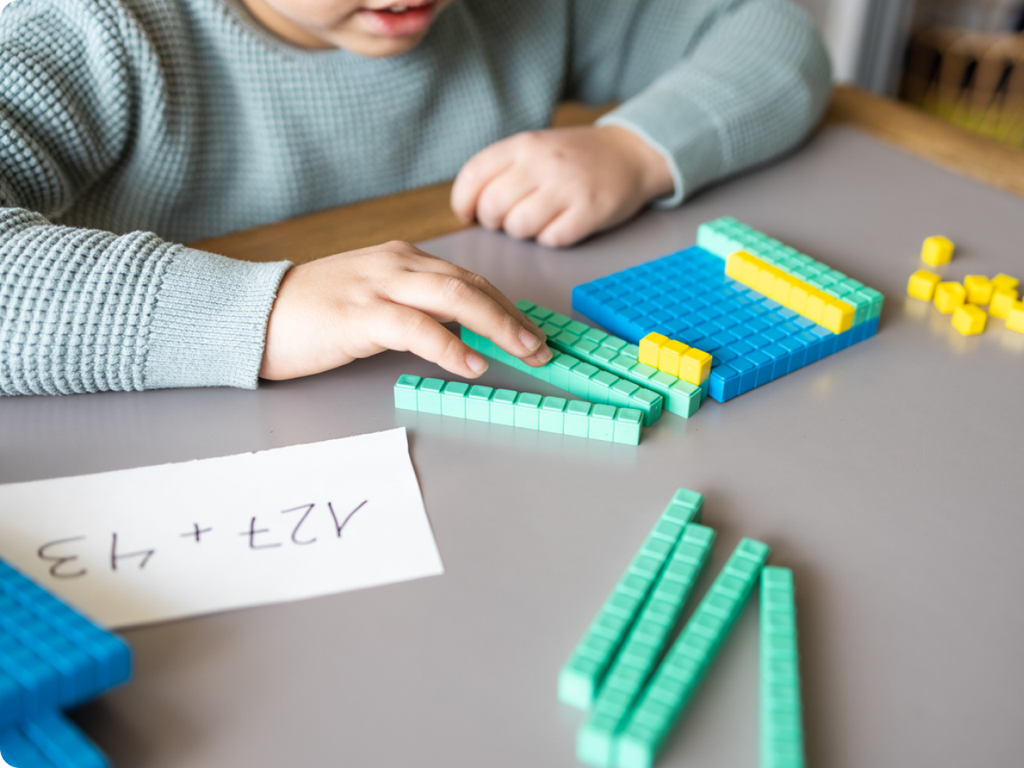Solve Equations
Subject: Math
Grade: Fourth grade
Topic: Mixed Operations
Please LOG IN to download the presentation. Access is available to registered users only.
View More Content
Introduction to Solving Equations
– Equations as a balancing act
– Think of each side of the equation as a balance scale.
– Solving: Finding the missing number
– To solve an equation means to find the value that makes the equation true.
– Simple equation examples
– For example, 4 + x = 10. What is x?
– Practice with balance visuals
– Use drawings of scales to understand equations better.
|
Begin the lesson by explaining that equations are like a balancing act, where both sides need to be equal. Use a seesaw or balance scale as a visual aid to demonstrate this concept. Emphasize that solving an equation means finding the missing number that makes both sides of the equation equal. Provide simple equations as examples and solve them together as a class. Encourage students to visualize the equations as balance scales, which can help them understand why both sides must remain equal. This foundational understanding will be crucial as they progress to more complex equations.
Mixed Operations Review
– Recap: addition, subtraction, multiplication, division
– Understand the order of operations (PEMDAS)
– PEMDAS stands for Parentheses, Exponents, Multiplication and Division, and Addition and Subtraction
– Solve practice problems together
– We’ll work through examples as a class to strengthen our skills
– Apply PEMDAS to mixed operations
– Use PEMDAS in problems with more than one operation
|
This slide is aimed at reviewing the fundamental arithmetic operations and the concept of the order of operations, which is crucial for solving equations. Start by quickly going over addition, subtraction, multiplication, and division to ensure that students recall these basic operations. Then, introduce the acronym PEMDAS to help them remember the sequence in which to perform operations in a mixed equation. Engage the class with practice problems that require the use of PEMDAS, and encourage them to solve the problems step-by-step. Emphasize the importance of following the correct order to get the right answer. Provide guidance and support as needed, and consider using real-life scenarios to demonstrate how mixed operations are used outside the classroom.
Setting Up Equations with Variables
– Understanding variables in equations
– Variables represent numbers in math problems, like ‘x’ or ‘y’.
– Steps to set up equations
– Read the problem, identify numbers and operations, and represent the unknown with a variable.
– Class practice: Equation creation
– We’ll work together to create equations from word problems.
|
This slide introduces the concept of variables in equations, which are symbols that stand for unknown numbers. It’s important to explain that variables can be any letter and that they are placeholders for numbers we want to find. Next, outline the steps to translate a word problem into an equation: read carefully, determine what we’re solving for, identify numbers and operations involved, and represent the unknown with a variable. During class practice, guide students through several examples, encouraging them to participate in setting up equations from word problems provided. This activity will help solidify their understanding and give them the confidence to tackle similar problems independently.
Solving One-Step Equations
– Solve with addition or subtraction
– If x – 3 = 4, what is x? Add 3 to both sides to find x.
– Solve with multiplication or division
– For 4x = 8, what is x? Divide both sides by 4 to solve for x.
– Work through examples together
– Let’s try x + 5 = 12 and 6x = 18 as a class.
– Practice solving on your own
– Try x – 2 = 7 and 9x = 27 for homework.
|
This slide introduces fourth graders to the concept of solving one-step equations using basic operations. Start by explaining that equations are like puzzles we need to solve to find the value of the unknown variable, usually represented by ‘x’. Demonstrate how to isolate ‘x’ by performing the opposite operation on both sides of the equation. For addition or subtraction, if the number is subtracted from ‘x’, we add to both sides, and if it’s added, we subtract. For multiplication or division, if ‘x’ is multiplied by a number, we divide both sides by that number, and if ‘x’ is divided, we multiply. Work through examples as a class to ensure understanding, then assign practice problems for independent work. Encourage students to show their work step by step.
Solving Two-Step Equations
– Understanding two-step equations
– Equations with two steps to find the answer, like 2x + 3 = 9.
– Inverse operations are key
– To solve, we do the opposite operation, like subtracting before dividing.
– Let’s see some examples
– Example: Solve 2x + 3 = 9. First, subtract 3, then divide by 2.
– Time for class practice
|
This slide introduces the concept of two-step equations, which require two operations to solve. Emphasize the importance of inverse operations, such as addition and subtraction or multiplication and division, to isolate the variable. Provide clear examples, like 2x + 3 = 9, and guide students through the steps of solving it. Subtract 3 from both sides to get 2x = 6, then divide both sides by 2 to find x = 3. After the explanation, engage the class with practice problems, ensuring to vary the difficulty and operations involved. Encourage students to explain their thought process as they solve each equation.
Strategies for Solving Equations
– Check work by plugging in answers
– After solving, substitute the solution back into the original equation to see if it works.
– Avoid common solving mistakes
– Mixing up operation signs and incorrect balancing can lead to errors.
– Tips for equation solving success
– Read the problem carefully, perform inverse operations, and always double-check your work.
– Practice with different equations
|
This slide aims to equip fourth-grade students with strategies to effectively solve equations. Emphasize the importance of checking their work by substituting the solution back into the original equation to verify its correctness. Highlight common mistakes such as mixing up addition and subtraction or multiplication and division, and the importance of keeping equations balanced. Provide tips like reading the problem carefully, using inverse operations to isolate the variable, and the necessity of double-checking work. Encourage students to practice these strategies with different types of equations to build confidence and proficiency.
Equation Relay Race: Team Challenge
– Split class into small teams
– Each member solves part of an equation
– Work together to solve the whole equation
– First team with correct solution earns a point
|
This class activity is designed to encourage teamwork and collaborative problem-solving among students. Divide the class into small teams, ensuring a mix of abilities in each group. Provide each team with a multi-step equation. Each member will be responsible for solving a part of the equation, then passing it on to the next member, like a relay race. The team that works together to solve the equation correctly first will earn a point. This activity helps students practice their mixed operation skills in a fun, competitive setting. Possible equations could vary in complexity, and you can have multiple rounds to give each team a chance to win. Ensure to walk around and assist teams as needed, and discuss the solutions as a class afterward.
Wrapping Up: Solving Equations
– Review of equation solving
– We learned steps to find the unknown number in math sentences.
– Practice makes perfect
– The more you solve, the better you get!
– Homework: Mixed operations worksheet
– Complete the worksheet to practice what we’ve learned.
– Keep practicing at home!
|
As we conclude today’s lesson, it’s important to recap the steps we’ve taken to solve equations. Emphasize to the students that becoming proficient at solving equations requires practice, just like learning a musical instrument or playing a sport. For homework, the students are assigned a worksheet that includes a variety of mixed operation equations to reinforce today’s lesson. Encourage them to try solving the equations on their own before seeking help. Remind them that making mistakes is a part of learning and that each problem they solve helps them understand the process better. In the next class, we can review any challenging problems together.






